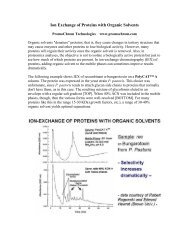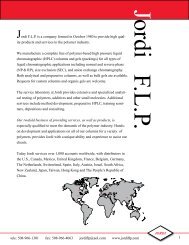Hydrophilic Interaction Chromatography (HILIC) - LC column, HPLC ...
Hydrophilic Interaction Chromatography (HILIC) - LC column, HPLC ...
Hydrophilic Interaction Chromatography (HILIC) - LC column, HPLC ...
Create successful ePaper yourself
Turn your PDF publications into a flip-book with our unique Google optimized e-Paper software.
<strong>Hydrophilic</strong> <strong>Interaction</strong> <strong>Chromatography</strong> (<strong>HILIC</strong>)<br />
PromoChrom technologies www.promochrom.com<br />
<strong>HILIC</strong> is a variant of normal phase chromatography that is performed with a very polar<br />
stationary phase and a mostly organic mobile phase. When the mobile phase contains ><br />
60% organic solvent, then hydrophilic interaction becomes significant. With neutral<br />
materials such as PolyHYDROXYETHYL A, this is the only significant force<br />
involved. With ion-exchange <strong>column</strong>s, hydrophilic interaction will be superimposed on<br />
the electrostatic effects. See the example of this with Histone H1 phosphorylation<br />
variants.<br />
Selectivity in <strong>HILIC</strong> is the opposite of that of RPC. It is very sensitive to addition or<br />
deletion of a Ser- or carbohydrate residue, less sensitive to addition or deletion of a Leu-<br />
or Phe- residue. Thus, the two modes are complementary and are sometimes used in<br />
sequence to purify complex mixtures. An example is the assessment of the degree of<br />
glycation of γ-interferon. The tryptic fragments are resolved on a RPC <strong>column</strong>. The two<br />
glycopeptide peaks are collected and rerun via <strong>HILIC</strong> on a PolyHYDROXYETHYL<br />
A <strong>column</strong>. This resolves each peak into a library of glycopeptide peaks, each differing<br />
from its neighbor by one carbohydrate residue.
Basic residues are the most hydrophilic, followed by phosphorylated residues. Next<br />
comes Asn-, Ser-, etc. with Phe- and Leu- being the least hydrophilic.<br />
The more polar a stationary phase, the less organic solvent necessary to get a given<br />
degree of retention. PolyHYDROXYETHYL A was designed to afford superior<br />
results in <strong>HILIC</strong>. Select the pore diameter that matches your application:<br />
1) 60- or 100-Å: Small solutes in general. See Metabolomics. The 3-µm, 100-Å material<br />
is particularly useful.<br />
2) 200- or 300-Å: Peptides and most proteins; di- and trinucleotides (ADP; NADH; etc.)<br />
3) 1000-Å: Extremely polar solutes such as ATP and aminoglycoside antibiotics (see<br />
Metabolomics).<br />
Salts: Essential to get reproducible retention times and symmetrical peaks. Usually, 10-<br />
15 mM suffices unless the solute is highly charged. Ammonium acetate or formate can be<br />
used if salt must be volatile. If the absorbance is to be monitored at low wavelengths such<br />
as 215 nm, then use triethylamine phosphate (TEAP) or sodium methylphosphonate. In<br />
cases where the solute is extremely well retained, such as intact proteins, try 50 mM<br />
formic acid as the additive.<br />
pH: Retention of peptides is maximal around pH 3. This is because they have a net +<br />
charge at that pH, and basic solutes are the most polar. Solutes that are not electrolytes<br />
are less sensitive to pH. NOTE: Selective isolation of glycopeptides: Dr. Steven Carr<br />
(Broad Institute) has observed that glycopeptides can be isolated from a tryptic digest<br />
with reasonable selectivity by <strong>HILIC</strong> on a PolyHYDROXYETHYL A <strong>column</strong> (e.g.,<br />
item# 202HY0503) with a decreasing ACN gradient and 15 mM ammonium acetate right<br />
out of the bottle (pH ~ 6.5). This seems to reflect the fact that retention due to the peptide<br />
moiety decreases from pH 3 to pH 6.5, while retention due to the glycan moiety is<br />
relatively unaffected. Thus, the contribution of the glycan to retention is a greater<br />
percentage of the total, and glycopeptides elute as a class immediately after the<br />
nonglycopeptides.<br />
Solvents: ACN and PrOH afford comparable retention. Backpressure is lower with ACN,<br />
while PrOH is a better solvent for intact proteins. An ACN:PrOH blend seems to be an<br />
even better solvent for proteins. BuOH affords even better retention than do these<br />
solvents, but its high viscosity limits the amount that can be employed.<br />
Intact proteins: While water-soluble proteins such as cytoplasmic enzymes do not lend<br />
themselves well to <strong>HILIC</strong>, <strong>HILIC</strong> works well for proteins that do not normally occur free<br />
in aqueous solution, such as membrane proteins and histones.<br />
PolyHYDROXYETHYL A is a trademark of Poly<strong>LC</strong> Inc.






